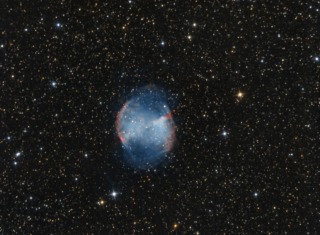
- Constellation: Vulpecula
- Right Ascension: 19h 59m 36.340s
- Declination: +22° 43′ 16.09″
- Distance: 415 ly
Messier 27 is often called the Dumbbell Nebula or Apple Core Nebula because of the brighter lobes on each side of it. It is located in the constellation of Vulpecula, at a distance of 1300 light years.
M27 is a planetary nebula which is a bit of a misnomer since it has nothing to do with planets. The first ones discovered looked a bit like planetary systems, but planetary nebula are created when a dieing star casts off its outer layers after a star's red giant phase. The nebula is made to glow from ionizing radiation from the remains of the star core which shrinks down to form a white dwarf.
Messier 27 was the first planetary nebula cataloged by Charles Messier.
- Details
- Category: Nebulas
- Telescope: GSO RC10
- Camera: ZWO 1600 MM
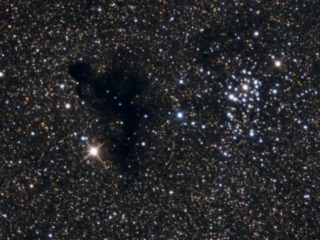
- Constellation: Sagittarius
- Right Ascension: 18h 3.5m
- Declination: -28 16m
- Distance: 5,100 ly
Barnard 86 is a dark nebula located in the constellation of Sagittarius. The nebula is dense enough to block the background stars in this densely populated area. Also visible is the open cluster NGC 6520, which may be associated with the nebula.
- Details
- Category: Nebulas
- Telescope: GSO RC10
- Camera: Atik 314l+
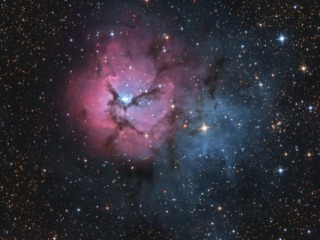
- Constellation: Sagittarius
- Right Ascension: 18h 02m 23s
- Declination: −23° 01′ 48″[
- Distance: 4,100 ly
Discovered by Charles Messier in 1764, the Trifid consists of several different components. First there is the open cluster of stars that formed from the nebula. The ionizing radiation from those stars causes the gas to glow with a reddish light. Reflecting star light of those stars off the surrounding dust gives us a blueish reflection nebula. Also visible are the thicker bands of dust and gas that give the nebula its name, roughly dividing it into three sections. The nebula lies approximately 5000 light years away in the constellation of Sagittarius.
- Details
- Category: Nebulas
- Telescope: GSO RC10
- Camera: ZWO 1600 MM
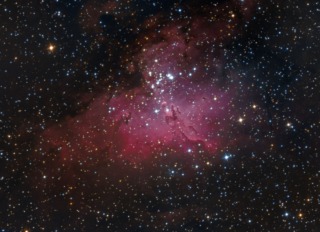
- Constellation: Serpens
- Right Ascension: 18h 18m 48s
- Declination: −13° 49'
- Distance: 5,700 ly
M16 is a young open cluster surrounded by an emission nebula, it was made famous by the Hubble image "Pillars of Creation" visible in the center of the nebula. NASA revisits the Eagle Nebula
The nebula has several active star forming regions in the nebula, and the nebula shines by emission light from the young massive O type stars. The cluster is located in the Sagittarius arm at a distance of about 7,000 light years away.
- Details
- Category: Nebulas
- Telescope: GSO RC10
- Camera: ZWO 1600 MM
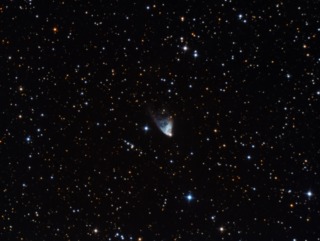
- Constellation: Monoceros
- Right Ascension: 6h 39m 10s
- Declination: +8° 45′
- Distance: 2,500 ly
NGC 2261 is often called Hubble's Variable Nebula. Named after Edwin Hubble, who carried out some of the earlier studies of this object. Discovered in 1783 by William Herschel, and was the first object photographed by the 200 inch Hale telescope.
It was Hubble who first noticed the changes in the nebula in photographs. The object changes in brightness and shadows in the structure of the nebula. The changes occur over weeks and months. The best theory explaining it, is dense knots of dust streamers cast shadows on the reflection nebula. The nebula is illuminated by the star R Mon, which is a young Orion type star. It is an irregular, eruptive type of variable star that can vary as much as 2 magnitudes in brightness.
- Details
- Category: Nebulas
Read more: NGC 2261 (2017) Hubble's Variable Nebula
- Telescope: GSO RC10
- Camera: ZWO 1600 MM
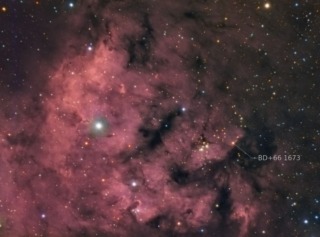
- Constellation: Cepheus
- Right Ascension: 00h 01m 08.58s
- Declination: +67° 25′ 17.0″
- Distance: 2,900 ly
NGC 7822 also referred to as Sharpless 171 is star forming region of gas and dust located in the constellation of Cepheus.
One of the stars in this region is BD+66 1673 is one of the hottest stars discovered in our corner of the galaxy with a surface temperature of 45,000K, and a luminosity of ~100,000 times of our Sun. It is an O5 type, and is also an Algol type eclipsing binary and the probable ionizing star of the region. It is also a member of the Berkley 59 star cluster.
- Details
- Category: Nebulas
- Telescope: EDT 80mm Reftactor
- Camera: Atik 314l+